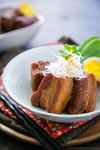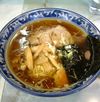Japan - food etc Flashcards
Japanese traditional high cuisine.
Kaiseki
Different chefs do it differently – court and samurai cuisine are more ornate, while temple and tea ceremony cuisine are more restrained
“kaiseki” (懐石) literally mean “breast-pocket stone”.
These kanji are thought to have been incorporated to indicate the frugal meal served in the austere style of chanoyu (Japanese tea ceremony). The idea came from the practice where Zen monks would ward off hunger by putting warm stones into the front folds of their robes, near their stomachs.
Shiru mono
soups / liquid things
Miso = fermented ___
+ salt
+ ____ (a fungus)
and sometimes rice, barley, or other ingredients.
Miso = fermented soybeans
+ salt
+ koji (a fungus)
and sometimes rice, barley, or other ingredients.
The result is a thick paste used for sauces and spreads, pickling vegetables or meats, and mixing with dashi soup stock to serve as miso soup called misoshiru.

A soy sauce and citrus juice condiment
Ponzu

Japanese stock
Dashi
出汁
The most common form of dashi is a simple broth made by heating water containing kombu (edible kelp) and kezurikatsuo (shavings of katsuobushi – preserved, fermented skipjack tuna or bonito) to near-boiling, then straining the resultant liquid
Red bean paste
Anko
a paste made of red beans (also called “azuki beans”)
Picture = Daifuku filled with red bean paste

Japanese type of rice wine
Mirin
similar to sake, but with a lower alcohol content and higher sugar content

Japanese - dried flakes, either skipjack tuna or bonito
Katsuobushi

Japanese - magnesium chloride (salt) used to make tofu
Nigari
Salt crystals you add to the soybeans & water mixture, which after steaming, coagulates into tofu

finely ground powder of specially grown and processed green tea leaves.
Matcha
The plants are shade-grown for about three weeks before harvest and the stems and veins are removed in processing. Shaded growth produces more theanine and caffeine.

Japanese Green bean snack
Edamame
Japanese mild-flavored winter radish
daikon

Japanese yellow citrus fruit
Yuzu
integral ingredient in ponzu

Japanese water greens
Mizuna

aka perilla flowers. Like a nettle
Shiso leaf

black seaweed, thin
Hijiki

seaweed in miso soup
Wakame

Japanese yam
Yamaimo

kelp, seaweed more likely to be sheets
Konbu

thin noodles made from buckwheat flour, or a combination of buckwheat and wheat flours
Soba

thick wheat noodles
Udon

one of the ingredients of Ramen
Kansui
Type of alkaline mineral water, containing sodium carbonate and usually potassium carbonate, as well as sometimes a small amount of phosphoric acid. Originated in Inner Mongolia, where some lakes contained large amounts of these minerals and whose water is said to be perfect for making these noodles. Instead of this kind of water you can add egg.
__ ramen. Brown broth.

Shōyu (醤油, “soy sauce”) ramen = brown broth.
A soup that is tangy, salty, and savory yet still fairly light on the palate. Shōyu ramen usually has curly noodles rather than straight ones
from Hokkaido. Thick, nutty, slightly sweet and very hearty
Miso ramen
Ramen first created in 1965 in Hokkaido
Curry ramen
spicy bean paste
Tōbanjan (豆瓣醤)

braised pork cubes or squares
Kakuni
Of Chinese origin
famous in the region of Nagasaki.
It literally means “square simmered”.

pink swirly thing
Narutomaki
Type of Kamaboko, i.e. cured surimi, a processed seafood product common in Japanese cuisine. Bit similar to crab sticks.

sliced pork
Chāshū 叉焼

dried seaweed
Nori 海苔

made from lactate-fermented bamboo shoots.
Menma 麺麻
The bamboo shoots are dried in the sun or through other means before the process of fermentation

green onions
Negi 葱
rolled sushi
Makizushi (巻き寿司, “rolled sushi”)

chilled
Hiyashi
Poke
diced raw fish served either as an appetizer or a main course and is one of the main dishes of Native Hawaiian cuisine
Poke = pokay. Hawaiian. Chunks of raw fish marinated in soy sauce and sesame oil, tossed with sesame seeds and seaweed
Traditional forms are aku (skipjack tuna) and heʻe (octopus) — usually called by its Japanese name tako poke

method of frying in oil.
Karaage
Similar to Tempura process. The food is marinated in a mix of soy sauce, ginger and garlic before being battered with wheat flour or potato starch.
deep-fried dish originally related to a French dish, the croquette
Korokke

Vinegar and miso dressed foods
Kake-ae

Japanese pancakes
Okonomiyaki

a dish in which veg is soaked in dashi broth, with sprinkled sesame seeds on top
Ohitashi

often the first course in a formal Japanese meal.
Sashimi
Recommend that it be eaten before other strong flavors affect the palate
Type of sashimi. Seared very briefly over a hot flame or in a pan, and can be briefly marinated in vinegar, sliced thinly and seasoned with ginger
Tataki













































